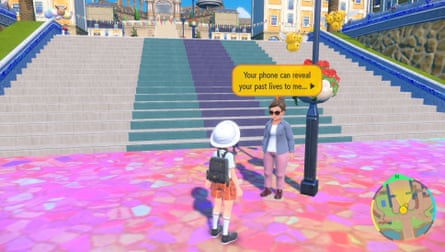Modern video games can be so perceptibly realistic – grass rippling in a gentle breeze, non-player characters going about their daily routines, faces and gestures that look so close to those of real humans – that they’ve started to call to mind Plato’s old chin-stroker about the cave (reimagined in 1999’s trench coat-flapping classic The Matrix.) What if we are all trapped inside a shockingly realistic illusion? Would we really know if we were inside a video game? If you’re looking for reassurance that we haven’t yet reached the singularity, boot up the ropey Pokémon Scarlet and Violet.
In this second Pokémon outing of the year, developer Game Freak abandons February’s Legends: Arceus’s intriguing feudal-era setting, but otherwise picks up where it left off. It aims to take the series’ expansive-yet-enclosed-environments to the next logical level: a seamless open world, where you can go where you want, catching and battling creatures as you travel. But Scarlet and Violet buckles violently under the weight of that ambition.
Initially, it all feels promising. We are thrown immediately into a shiny-looking character creator, and the slick presentation is a world away from the Pokémon of yore. After selecting a fresh haircut and slowly tweaking my avatar’s bulbous anime eyes, the screen shifts to reveal a filled-out school application form. This refreshingly modern prologue segues into a cut-scene, sweeping across the Paldea region’s sprawling plains and introducing the Uva Academy – a Hogwarts-esque boarding school for budding Pokémon trainers.
But on setting foot outside your house – the classic first step on all Pokémon adventures – the wheels fall off. Much like Arceus, Scarlet and Violet are games that dream big, but are beaten down by reality. It’s not hyperbole to say that Scarlet/Violet is one of the worst-looking – and running – games I’ve ever played. Pokéballs get stuck in rocks. The frame-rate in the open world constantly judders to a crawl. City buildings shimmer like a bad Photoshop cut-job, and the ground regularly disappears under your Pokémon, mid-battle.
Tragically, beneath the shonky surface, Scarlet/Violet’s game loop is the most compelling Pokémon’s been in decades. With the freedom of a gigantic world map to be explored, Scarlet and Violet come closest yet to capturing the spirit of a true globetrotting adventure. To fit Paldea’s new free-form mould, you can now follow three different quest paths: gym badges (Victory Road), base-clearing (Starfall Street), and defeating giant Pokémon (Path of Legends). The Victory Road path is a classic gym-challenging romp, and the most enjoyable. Another questline rewards your sentient motorbike Pokémon (yes, really) with new acrobatic abilities. While not every mission is a winner, the flexibility of this new approach is welcome, and the sheer variety of quests and beckoning digital distractions creates a satisfying checklist of Pokédex-filling busywork. It makes Scarlet and Violet the perfect handheld companion for half-watching a TV show.
While its offensively low-poly environments wouldn’t look out of place in a smartphone app, battle animations are endearingly expressive, regularly coaxing a smile. And to Game Freak’s credit, it’s hard to overstate just how many true-to-scale critters now roam any given area, from ankle-high Igglybuffs scuttling underfoot to the pig-like Lechonk with its grunting trot. Free-roaming exploration makes catching Pokémon exciting.

Minor experiential improvements come thick and fast, too. Your beloved ’mon are now able to recall old moves, the camera pivots helpfully in the direction of objective markers, and you can even “auto-heal” your wounded warriors. It’s also one of the tougher Pokémon games of recent years; bases and gyms actually require some effort and grind if you want to defeat them, presenting a nice change from the pushover previous mainline entries Sword and Shield.
This is what makes Scarlet/Violet such a frustrating experience: there’s no shortage of good ideas, but they are muddied by poor execution, meaning that one of the highest-grossing entertainment franchises around feels jarringly cheap. This is especially true of the towns you visit. While a cavalcade of lively creatures stomp and scuttle across Paldea’s pixelated plains, cities can barely handle the footfall. Zooming across town on your motorbike Pokémon, characters stall and stutter like treacle-coated marionettes. Most buildings can’t be entered. Shops abandon previously fully rendered interiors for a simple “buy” menu.
It all feels like a rush job – a Pokemon RPG yanked prematurely into a cruelly well-lit, higher-definition world. For decades, Game Freak lived in something of a bubble, obliviously perfecting Nintendo DS pixel art in 256p resolution as the rest of the industry mastered high-definition worlds. Since the 2017 launch of Nintendo’s Switch console, the developer has been desperately playing catch-up.
Here, Game Freak draws up an exciting new open-world blueprint for the Pokémon franchise, but appears to have lacked the time and knowhow to deliver it to spec. Compare this with June’s gorgeous Xenoblade Chronicles 3, which runs on the same console, and it’s hard to shake the feeling that you’re beta testing an open-world Pokémon. With more time in the oven, this could have been genuinely exciting. As it stands, this fun-filled adventure asks you to put up with an awful lot more of the rough than the smooth.

